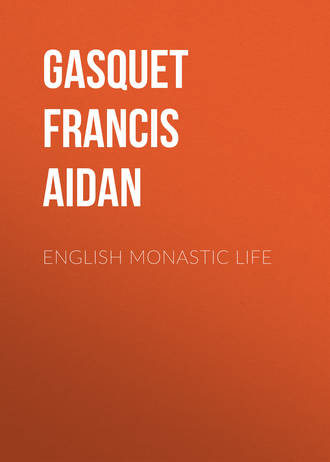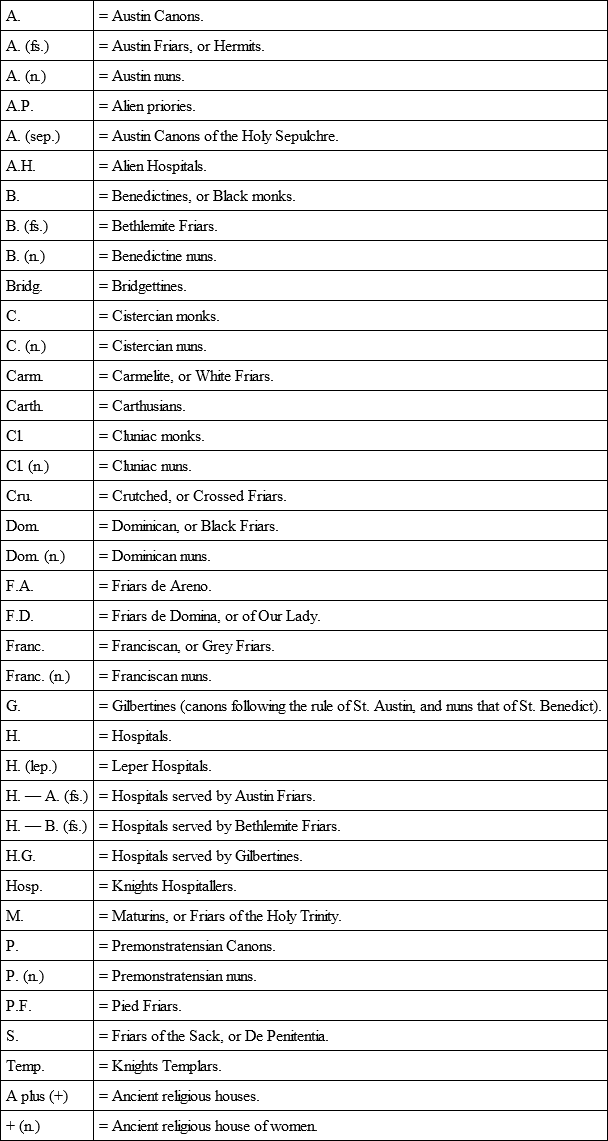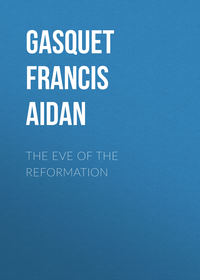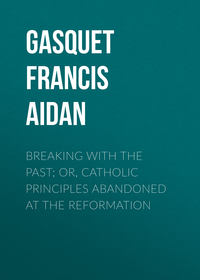 полная версия
полная версияEnglish Monastic Life
ii. The Franciscan, or Grey Friars
St. Francis the founder of the Grey Friars was contemporary with St. Dominic, and was born at Assisi, in the province of Umbria in Italy, in A.D. 1182. These friars were called Franciscans from their founder; “Grey Friars” from the colour of their habit; and “Minorites” from their humble desire to be considered the least of the Orders. Their rule was approved by Innocent III. in A.D. 1210 and by the General Council of the Lateran in A.D. 1215. Their dress was made of a coarse brown cloth with a long pointed hood of the same material, and a short cloak. They girded themselves with a knotted cord and went barefooted. The Franciscan Friars first found their way to England in A.D. 1224, and at the general destruction of Regular life in England in the sixteenth century they had in all about sixty-six establishments. A reformation of the Order to primitive observance was made in the fifteenth century and confirmed by the Council of Constance in A.D. 1414. The branches of the Order which adopted it became known as “Observants” or “Recollects.” This branch of the Order was represented in England by several houses built for them by King Henry VII., although they are supposed to have been brought into England in the time of Edward IV.
The whole Order in England was divided into seven “Custodies” or “Wardenships,” the houses being grouped round convenient centres such as London, York, Cambridge, Bristol, Oxford, Newcastle, and Worcester. Harpsfield says that the “Recollects” or “Observants” had six friaries, at Canterbury, Greenwich, Richmond, Southampton, Newark, and Newcastle.
The Minoresses, or Nuns of St. ClareThe Minoresses were instituted by St. Clare, the sister of St. Francis of Assisi, about A.D. 1212, as the branch of the Franciscan Order for females. They followed the Rule of the Friars Minor and were thus called “Minoresses,” or Nuns of St. Clare, after their foundress. They wore the same dress as the Franciscan Friars, and imitated them in their poverty, for which cause they were sometimes known as “Poor Clares.” They were brought to England somewhere about A.D. 1293, and established in London, without Aldgate, in the locality now known as the Minories. The Order had two other houses, one at Denney, in Cambridgeshire, in which at the time of the general dissolution there were some twenty-five nuns; and the other at Brusyard in Suffolk, which was a much smaller establishment. The nuns at Denney had previously been located at Waterbeche for about fifty years, being removed to their new home by Mary, countess of Pembroke, in A.D. 1348.
iii. Carmelites
The Carmelite Friars were so called from the place of their origin. They were also named “White Friars” from the colour of the cloak of their habit, and Friars of the Blessed Virgin. These friars are first heard of in the twelfth century, on being driven out of Palestine by the persecution of the Saracens. Their Rule is chiefly founded on that of St. Basil, and was confirmed by Pope Honorius III. in A.D. 1224, and finally approved by Innocent IV. in 1250. They were brought into England by John Vesey and Richard Grey, and established their first houses in the north at Alnwick, and in the south at Ailesford in Kent. At the latter place the first European Chapter of the Order was held in A.D. 1245. In the sixteenth century there were about forty houses in England and Wales.
iv. Austin Friars, or Hermits
The body of Austin Friars took its historical origin in the union of several existing bodies of friars effected in A.D. 1265 by Pope Clement IV. They were regarded as belonging to the ranks of the mendicant friars and not to the monastic Order. They were very widely spread, and in Europe in the sixteenth century they are said to have possessed three thousand convents, in which were thirty thousand friars; besides three hundred convents of nuns. In England at the time of the dissolution they had some thirty-two friaries.
V. The Lesser Friars
i. Friars of the Sack, or De Penitentia
These brethren of penance were called “Friars of the Sack” because their dress was cut without other form than that of a simple bag or sack, and made of coarse cloth, like sackcloth. Most authorities, however, represent this as merely a familiar name, and say that their real title was that of Friars, or Brethren of Penance. They took their origin apparently in Italy, and came to England during the reign of Henry III., where, about A.D. 1257, they opened a house in London. They had many settlements in France, Spain, and Germany, but lost most of them after the Council of Lyons in A.D. 1274, when Pope Gregory X. suppressed all begging friars with the exception of the four mendicant Orders of Dominicans, Franciscans, Austin Friars, and Carmelites. This did not, however, apply universally, and in England the Fratres de Sacco remained in existence until the final suppression of the religious Orders in the sixteenth century. The dress of these friars was apparently made of rough brown cloth, and was not unlike that of the Franciscans; they had their feet bare and wore wooden sandals. Their mode of life was very austere, and they never ate meat and drank only water.
ii. Pied Friars, or Fratres de Pica
These religious were so called from the colours of their habit, which was black and white, like a magpie. They had but one house in England, at Norwich, and had only a brief existence, as the Pied Friars were obliged, by the Council of Lyons, to join one or other of the four great mendicant Orders. Their house, which, according to Blomfield, stood in the north-east corner of the churchyard of St. Peter’s Church, was given to the Hospital of Bek, at Billingford in Norfolk.
iii. Friars of St. Mary de Areno
These friars had likewise but one house, at Westminster, founded towards the end of the reign of Henry III. They, too, were short-lived as a body, falling under the law of suppression of the lesser mendicant Orders. They, however, continued for a few years longer, as Tanner quotes a Close Roll of 11 Edward II., to show that they were only dissolved in that year, A.D. 1318.
iv. Friars of Our Lady, or de Domina
The Friars of Our Lady are said to have lived under the Rule of St. Austin. They had a white habit, with a black cloak and hood. They were instituted in the thirteenth century, and had a house at Cambridge, near the castle. Before A.D. 1290 they were also settled at Norwich, where they continued until the great Pestilence in 1349, of which they all died.
v. Friars of the Holy Trinity, or Trinitarians
These religious were founded by SS. John of Matha and Felix of Valois about A.D. 1197 for the redemption of captives. They were called “Trinitarians,” because by their rule all their churches were dedicated to the Holy Trinity, or “Maturines,” from the fact that their original foundation in Paris was near St. Mathurine’s Chapel. The Order was confirmed by Pope Innocent III., who gave the religious white robes, with a red and blue cross on their breasts, and a cloak with the same emblem on the left side. Their revenues were to be divided into three parts; one for their own support, one to relieve the poor, and the third to ransom Christians who had been taken captive by the infidels. They were brought to England in A.D. 1244, and were given the lands and privileges of the Canons of the Holy Sepulchre on the extinction of that Order. According to the Monasticon, they had, in all, eleven houses in this country; but these establishments were small, the usual number of religious in each being three friars and three lay brothers. The superior was named “minister,” and included in his office the functions of superior and procurator; and the houses were united into a congregation under a Minister major, who held a general Chapter annually for the regulation of defects and the discussion of common interests.
vi. Crutched, or Crossed Friars
The Crossed Friars are said by some to have taken their origin in the Low Countries, by others to have come from Italy in very early times, having been instituted or reformed by one Gerard, prior of St. Maria di Morella at Bologna. In 1169 Pope Alexander III. took them under his protection and gave them a fixed rule of life. These friars first came to England in the year 1244. Matthew Paris, writing of that time, says that they appeared before a synod held by the bishop of Rochester, each carrying a stick upon which was a cross. They presented documents from the pope and asked to be allowed to make foundations of their fraternity in England. Clement Reyner puts their first establishment in this country at Reigate, in 1245, and their second in London in 1249. This last is the better known, as it has given the name of Crutched Friars to a locality in the city of London. The friars had a third house at Oxford, and altogether there were six or seven English friaries. Besides the cross upon their staves, from which they originally took their name, the friars had a red cloth cross upon the breasts of their habits.
vii. The Bethlemite Friars
The origin of these friars is uncertain, and they were apparently only known in England, and so may perhaps be considered to have had their beginning in this country. Matthew Paris says that in the year 1257 they were given a house at Cambridge, in Trumpington Street. He describes their dress as being very like that of the Dominicans, from which it was distinguished only by having a red star, of five points with a round blue centre, on the scapular. This badge recalled the meaning of their name, representing as it did the star which led the Magi to Bethlehem.
viii. The Bonshommes
These friars were apparently of English origin. Some have thought that they were the same as the “Friars of the Sack,” but this is by no means clear. Polydore Vergil says that Edmund of Cornwall, the brother of Henry III., on his return from Germany in A.D. 1257, built and endowed a fine monastery at Ashridge. This he gave “to a new order of men, never before known in England, called Boni Homines, the Bonshommes. They followed the rule of St. Augustine, wearing a blue-coloured dress of a form similar to that of the Augustinian hermits.” The only other house possessed by the Bonshommes was at Edingdon.
LIST OF ENGLISH RELIGIOUS HOUSES
An asterisk (*) prefixed to a religious house signifies that there are considerable remains extant.
A dagger (†) prefixed signifies that there are sufficient remains to interest an archæologist.
No attention is paid to mere mounds or grass-covered heaps.
For these marks as to remains the author is not responsible. They have kindly been contributed by Rev. Dr. Cox and Mr. W. H. St. John Hope, who desire it to be known that they do not in any way consider these marks exhaustive; they merely represent those remains with which one or other, or both, are personally acquainted.
The following abbreviations for the names of the religious Orders, etc., have been used in the list: —





1. A preceptory of Knights of St. Lazarus, temp. Edw. III.
2. For London, see also Clerkenwell and Haliwell.
1
Texts and Studies, Cambridge, vol. vi., No. 1, p. 233.
2
Ibid.
3
Ibid., p. 234.
4
Ibid., p. 235.
5
Ibid., p. 236.
6
Ibid., p. 247.
7
Ibid., p. 256.
8
The Celtic Church of Wales, J. J. Willis Bund, p. 166.






